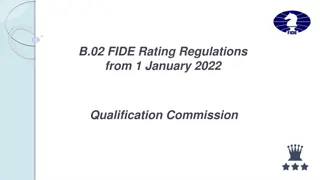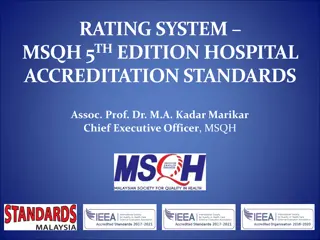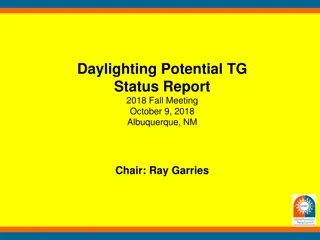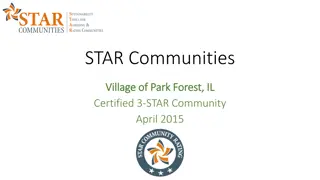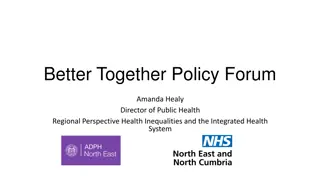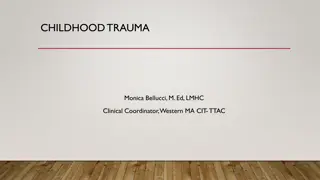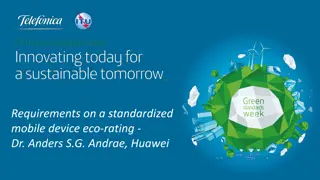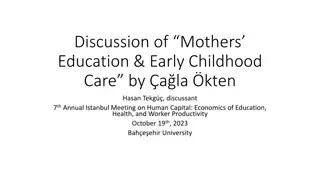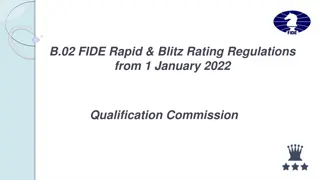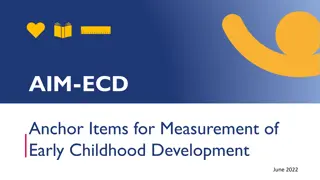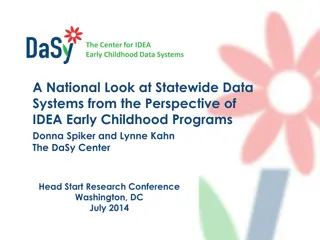Understanding Quality Rating and Improvement Systems (QRS) and Early Childhood Integrated Data Systems (ECIDS)
This webinar provides an overview of QRS and ECIDS, discusses state considerations for their coordination, and highlights resources supporting their alignment. QRS aims to measure and improve the quality of early care and education programs, increase access for children with high needs, and enhance parent decision-making. The components of QRS include quality standards, measurement processes, improvement supports, incentives, and parent education.
Download Presentation

Please find below an Image/Link to download the presentation.
The content on the website is provided AS IS for your information and personal use only. It may not be sold, licensed, or shared on other websites without obtaining consent from the author. Download presentation by click this link. If you encounter any issues during the download, it is possible that the publisher has removed the file from their server.
E N D
Presentation Transcript
SLDS State Support Team Webinar The webinar will begin at approximately 1:30 PM EST. Please note that all attendees will remain muted throughout this webinar. If you would like to ask a question, please type it into the Q&A box and click Send. After the presentation, the SST facilitator will then address your question to the panelists. This webinar is being recorded. A link to the recording as well as a copy of the presentation will be made available for later viewing. Thank you for joining us! SLDS Webinar 10/01/14 1
QUALITY RATINGAND IMPROVEMENT SYSTEMS (QRIS) AND EARLY CHILDHOOD INTEGRATED DATA SYSTEMS (ECIDS)
WELCOME Objectives Provide an overview of QRIS and ECIDS Discuss state considerations for the coordination between QRIS and ECIDS Highlight a complementary set of resources that support coordination of QRIS and ECIDS INQUIRE Toolkit ECIDS Toolkit CEDS RTT-ELC and SLDS TA Briefs Panelists Kathryn Tout, Child Trends and INQUIRE (supported through OPRE in the Administration for Children and Families, U.S. DHHS) Kathy Thornburg, ELC State Support Team, AEM Missy Cochenour, SLDS State Support Team and Program Manager - Early Childhood Data, AEM SLDS Webinar 10/01/14 3
A QRIS IS A system to measure, rate, and disseminate information about the quality of early care and education programs SLDS Webinar 10/01/14 5
QRIS GOALS* Improve the quality of early care and education programs Increase the number of children with high needs who participate in high-quality programs Support parent decision- making about early care and education Support/improve children s development and school readiness *QRIS goals are specific to each state/locality. This list reflects general trends. SLDS Webinar 10/01/14 6
QRIS COMPONENTS* 1) Quality standards and indicators 2) Process for measuring quality and assigning ratings 3) Quality improvement supports for programs 4) Incentives for program participation 5) Parent/consumer education and dissemination of ratings *While there are common dimensions of QRISs across states/localities, the actual details and implementation of QRISs vary widely SLDS Webinar 10/01/14 7
QRIS DATA QRISs are data producers and consumers Examples of Data Consumed/Needed Examples of Data Produced Scores from observations of the environment and interactions Licensing status and type and updates on violations/compliance Workforce qualifications and training for individual staff and directors Scores on quality indicators Publicly available ratings of quality Number of children receiving subsidies QRIS ratings data are visible publicly, which makes the use of data distinct from other data in early care and education SLDS Webinar 10/01/14 8
CURRENT QRIS DATA CHALLENGES As with other data system efforts, QRISs use multiple data sources, which increases the risks to data quality Data documentation is limited Lack of governance process Connecting QRISs and source systems to the ECIDS can help address these data challenges SLDS Webinar 10/01/14 9
QRIS DATA RESOURCES INQUIRE Data Toolkit http://inquiredatatoolkit.org/ Governance issues Best Practices in Data Governance and Management for Early Care and Education: Supporting Effective Quality Rating and Improvement Systems o http://www.acf.hhs.gov/sites/default/files/opre/iruka_brief_5 08_compliant1_optimized.pdf Data quality issues Best Practices in Ensuring Data Quality in Quality Rating and Improvement Systems http://www.acf.hhs.gov/sites/default/files/opre/data_quality_ brief_508_compliant.pdf o o SLDS Webinar 10/01/14 10
WHAT ISAN ECIDS? Collects, integrates, maintains, stores, and reports information from early childhood programs Crosses multiple agencies within a state that serve children and families from birth to age 8 Includes data on the individual child, the child s family, the classroom, the program/providers, and other services that provide comprehensive care and education for young children (What is an ECIDS, NCES 2014) SLDS Webinar 10/01/14 12
WHAT ISAN ECIDS? SLDS Webinar 10/01/14 13
EXAMPLESOF RESULTSOFAN ECIDS Answer critical program and policy questions across agencies that provide services to children and families within a state. For example: What are the education and economic returns on early childhood investments across state programs? Are we preparing all of our children for kindergarten, as a whole and by subgroups? What characteristics of programs are associated with positive outcomes for children? Unduplicated count of children Allocation of resources across agencies NOT: Replacing program data systems used for operational or key instructional decisions. SLDS Webinar 10/01/14 14
FUNDING ECIDS RTT-ELC States ECIDS Round 1 RTT-ELC States ECIDS Round 2 RTT-ELC States ECIDS Round 3 States Using SLDS for ECIDS EC Specific (U.S. Virgin Islands) States Using SLDS Grant to Include EC in P-20 States Using Internal Resources for ECIDS ECCS Grant Toward ECIDS (Utah) States Not Working Toward an ECIDS SLDS Webinar 10/01/14 15
ED FUNDING EARLY LEARNING DATA SYSTEMS SLDS AND RTT-ELC SLDS (ARRA, FY12) Many states began incorporating P into SLDSs early on According to SLDS program data, 21 states include a focus on building an ECIDS connected to K12/P-20 systems via SLDS In FY12, one state/territory was funded specifically to focus on building an ECIDS Virgin Islands o RTT-ELC States could choose to build or enhance a coordinated early childhood data system (Selection Criteria E2) 16/20 RTT-ELC (rounds 1-3) grantees have data systems included in their scopes of work SLDS Webinar 10/01/14 16
ECIDS RESOURCES ECIDS Toolkit https://slds.grads360.org/#program/ecids-toolkit SLDS Issue Briefs Answering Key Questions with an Early Childhood Data System http://nces.ed.gov/programs/slds/pdf/IssueBrief_Answering_key_que stions_with_an_early_childhood_data_system.pdf Identifying SLDS Users and Their Information Needs https://slds.grads360.org/#communities/pdc/documents/2753 Early Childhood Data Governance In Action! An Introduction http://nces.ed.gov/programs/slds/pdf/EC_DataGovernance.pdf Early Childhood Data Governance In Action! Initial Steps to Establish Data Governance http://nces.ed.gov/programs/slds/pdf/EC_DataGovernance_Initial.pdf o o o o o SLDS Webinar 10/01/14 17
QRIS AND ECIDS COORDINATION
DISTINCTIONSBETWEENA QRIS AND AN ECIDS QRIS ECIDS To improve and communicate information about the quality of early care and education To answer program and policy questions that cannot be answered using any one data system Purpose Education Human/Social Services Universities Office of Early Learning Cross agencies: Education, Human Services or Social Services, Office of Early Learning Who Leads? Are we preparing all of our children for kindergarten, as a whole and by subgroups? Example: What percentage of publicly funded programs have teachers with BAs? What is the quality of the program? Example: Do 50 percent of staff in the program have a BA? Questions Disaggregated (raw) and can be aggregated in different ways Data Types Disaggregated or aggregated
CONSIDERATIONS MADEBY QRISSTO CALCULATE INDICATOR SCORE Employed at Time of Rating Full-Time Teachers Only, Assistants Education Level Director Assigned to Classroom Do 50 percent of staff in the program have a BA?
HOWTO COORDINATEA QRIS AND AN ECIDS 1. Understand the audience QRIS: workforce, legislators, families, researchers ECIDS: workforce, legislators, families, researchers 2. Identify the purposes QRIS: to improve and communicate information about the quality of early care and education programs ECIDS: to answer program and policy questions that cannot be answered using any one given data system Both work across programs 3. Articulate the benefits of working together 4. Begin by establishing a common understanding of why certain data are collected, what data are needed by either, and any duplication 5. Start the conversation! SLDS Webinar 10/01/14 21
CHALLENGESINTHE RELATIONSHIP BETWEEN QRIS AND ECIDS Technical challenges Designing a system that meets the various needs of multiple audiences (This is the challenge of an ECIDS by its nature) Communication challenges Articulating the needs, challenges, and solutions The different audiences, purposes, and lead agencies can make these efforts feel as if they are on different tracks SLDS Webinar 10/01/14 22
BENEFITSOF COORDINATED QRIS AND ECIDS Clarity about the purposes of the QRIS and ECIDS By coordinating, there could be stronger data standards and policies supporting data quality Increased capacity to analyze program and policy questions SLDS Webinar 10/01/14 23
REFLECTIONSFROMTHE PAST Questions we were asking related to programs and child outcomes in 1994 and for that matter in 2004 Are children better prepared for kindergarten if they attended half-day programs, full-day programs, or were at home? In 2014, we can answer more refined questions. We can know not only what programs, how many programs, at what ages, the length of day, if the program was quality-rated and what the quality was, level of education of teacher, income of family, health indicators, and so much more SLDS Webinar 10/01/14 25
POSSIBLE DATAIN ECIDS TO INFORM POLICY
TECHNICAL QUESTIONTO CONSIDER Has your ECIDS been designed to include another source system, such as a QRIS, over time?
POSSIBLE QUESTIONSTO ANSWER WHEN QRIS DATAARE COORDINATED WITHTHE ECIDS What percentage of children receiving child care subsidies receive care at programs that are rated in the top levels of the QRIS? Do children on subsidy who attend a QRIS-rated program have better outcomes than children on subsidy who do not attend a QRIS-rated program? And, at what level of rating? Compared to programs that are not enrolled in the QRIS, do QRIS-rated program sites differ on key characteristics such as geography, program type, funding, or director qualifications? SLDS Webinar 10/01/14 28
MORE POSSIBLE QUESTIONS TO ANSWER What factors are associated with increased QRIS ratings over time? What amount of TA provided to QRIS programs helps programs increase their rating? What specific features of TA are linked to positive outcomes (e.g., dosage, intensity)? Are there particular TA approaches/methods that are more successful with home vs. center programs? SLDS Webinar 10/01/14 29
STATE-IDENTIFIED NEED We realized we had a working group on ECIDS and another on QRIS and we needed to talk to each other. SLDS Webinar 10/01/14 30
STAFF ROLE CONSIDERATIONS ECIDS Project Teams should: Work with QRIS Administrators to determine what level of data about the rating is needed Include appropriate QRIS staff in data governance if they are contributing data to the ECIDS QRIS Administrators should: Determine what data are appropriate to include in the ECIDS Determine what data are needed from the ECIDS to calculate the program ratings (e.g., licensing, registry, etc.) SLDS Webinar 10/01/14 31
SUMMARY QUESTIONSFOR STATE CONSIDERATIONS: GETTING STARTED Who is working on the QRIS and the ECIDS in your state? What is the purpose of the QRIS and ECIDS in your state? What data are reported and at what level (aggregated/disaggregated)? What are the key data sources for the QRIS and ECIDS? Where do the key data sources originate for the QRIS and ECIDS? What data are being captured in both? SLDS Webinar 10/01/14 33
IN SUMMARY Work on the QRIS and the ECIDS together regardless of who is leading Think about long-term needs and sustainability of both the QRIS and the ECIDS Consider examples of shared data elements across both systems to support the broader policy and program initiatives in the state
QUESTIONS OR COMMENTS?
CONTACTS Kathryn Tout, ktout@childtrends.org Kathy Thornburg, Kathy.thornburg@elcta.org Missy Cochenour, missy.cochenour@sst-slds.org Lauren Wise, lauren.wise@aemcorp.com SLDS Webinar 05/28/14 36




